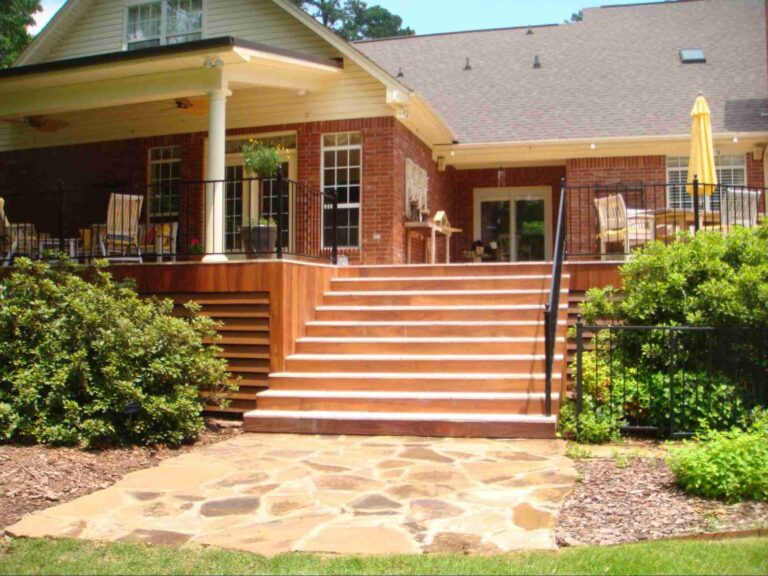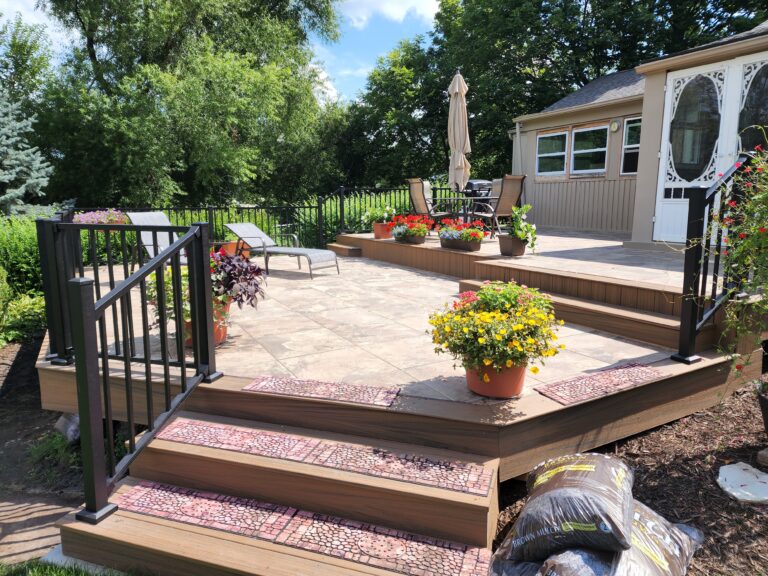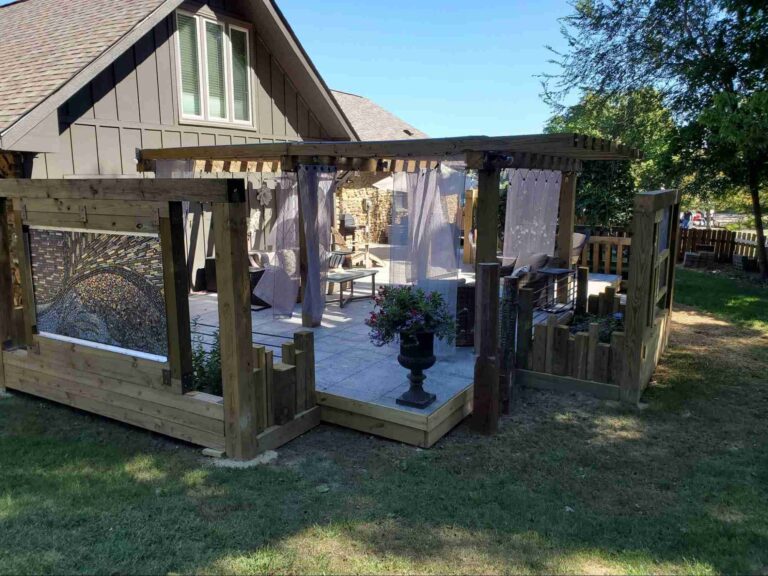Deciding between a raised or ground-level deck is a crucial decision in the design of your outdoor living space. Each type brings its unique set of benefits and challenges, requiring careful consideration of your needs, budget, and backyard layout. In this article, we will dive into the pros and cons of both raised and ground-level decks, setting the stage for an informed assessment of your options.
Additionally, we will explore how the game-changing StoneDeks System can impact these types of projects, allowing for the use of hardscape materials such as stone and pavers to build raised and ground-level decks.
Raised Decks

Raised decks offer an elevated vantage point and are constructed higher than 30 inches above the ground. They are often connected to the home and provide a splendid panoramic view of the surrounding landscape. From a raised deck, you’ll feel as if you’re surveying your kingdom from a hilltop castle, with a vast, breathtaking panorama stretched out in front.
One of the key strengths of raised decks lies in their adaptability. Ideal in sloped terrains, elevated decks can make the most of uneven space that would otherwise be underutilized. Furthermore, an elevated deck can create additional living space on the second story of your home, capitalizing on vertical space.
Safety considerations are integral to the design of raised decks. Railings, for instance, are mandatory. There are also more permits required than with a ground-level deck.
It is important to note that although typically attached to the home, raised decks can also be freestanding, accommodating specific needs such as integration with above-ground pools. This versatility adds to their overall value and appeal in various outdoor settings.
Pros Of Raised Decks
- Better views: Enjoy sweeping vistas. Ideal for scenic locations or homes with limited ground-level views.
- Space optimization: Make use of sloped or uneven terrain that might otherwise be underutilized.
- Less maintenance: Increased elevation reduces the risk of mold and moisture damage beneath the deck.
- Can capitalize on vertical space: When attached to a home’s second story, raised decks create the potential for extra outdoor living space.
- Feels like an extension of your home: Most raised decks are attached to the house and feel like an extension of your indoor living space.
Cons Of Raised Decks
- More complex installation: Elevated structures can be more expensive due to the increased materials and labor required for construction.
- Requires additional safety measures: Railings are mandatory to prevent accidents.
- Permit requirements: Raised decks require more permits, which can result in additional costs and time spent on the application process.
Can I Use The StoneDeks System For A Raised Deck?

Don’t just limit yourself to wood or composite decking materials. You can now use the StoneDeks System to build a raised stone deck!
The core component of the StoneDeks System, the Silca Grate, is designed with one main purpose: to help you easily and cost-effectively install stone on your deck.
Our product is installed directly onto wooden or metal joists, allowing you to lay down virtually any hardscape material on your deck frame structure. Whether you choose natural stone, porcelain, pavers, or travertine, our system offers design flexibility, durability, low maintenance, and easy installation.
Check out these elevated stone deck ideas and discover the possibilities!
Ground Level Decks

Ground-level decks, as the name suggests, are constructed at or near ground level. These decks are characterized by their low height of under 30 inches. Due to their low profile, they do not require railings, giving them an unobstructed look.
While ground-level decks can be attached to the house, they are more frequently constructed as freestanding structures. These decks might not feature posts and can be built directly on the ground, making them ideal for level terrain and even surfaces.
A distinct feature of ground-level decks is their seamless integration with your landscape. Their low-profile design and lack of barriers help to create a harmonious transition between different areas.
Ground-level decks are a more budget-friendly option than their elevated counterparts. The simple design means fewer materials and less labor are required, translating into lower overall construction costs. Plus, they usually do not require a permit, saving you on any costs associated with the permit application process.
Pros Of Ground-Level Decks
- Budget-friendly: Ground-level decks require fewer materials and labor, making installation faster and more affordable than raised decks.
- Seamless landscape integration: The low-profile design helps create a smooth transition between your yard and the deck.
3. No need for railings: Since they are constructed close to the ground, they do not require railings for safety. - Fewer permits are required: In most cases, ground-level decks do not require any permits.
- Easier for DIYers: Overall, ground-level decks are an excellent project for DIYers.
Cons Of Ground-Level Decks
- Limited views: Being closer to the ground, ground-level decks do not offer the same dramatic views that elevated decks provide.
- Limited usage on uneven terrain: Ground-level decks are best suited for level ground, making them unsuitable for sloping or uneven terrain.
- Increased maintenance: Ground-level decks are more susceptible to issues such as poor drainage, pests, mold, and moisture damage due to their direct contact with the ground.

Can I Use The StoneDeks System For A Ground-Level Deck?
There are many ways to use the StoneDeks system for ground-level decks.
Utilizing Silca Grate For Hardscape Integration:
Our Silca Grate makes it easy to incorporate hardscape materials, such as stone or pavers, into your deck’s design as an alternative to wood decking. The grates are installed onto the joists of your deck, allowing you to then lay your chosen hardscape material on them. You can even combine different materials – like stone and wood decking – within the same deck, creating unique and visually appealing designs that integrate seamlessly with the surrounding landscape and hardscape elements.
Enhancing Stability And Drainage With Silca SoilGrid:
For projects requiring a stable foundation with excellent drainage, the Silca SoilGrid is the perfect solution. Acting as an alternative to a traditional gravel foundation, this heavy-duty linking grid can be used to establish a solid base for your ground-level deck. Silca SoilGrid improves stability and promotes better drainage, helping to prevent common types of damage and reducing maintenance costs. Ultimately, it contributes to the longevity and durability of your deck, ensuring that it stands strong against both time and the elements.
Overview
In conclusion, raised decks are perfect for those seeking an elevated viewpoint, adaptability to uneven terrain, and the potential for additional living space. In contrast, ground-level decks offer a budget-friendly price point, seamless landscape integration, and fewer permit requirements.
The revolutionary StoneDeks System can enhance both of these deck types. The Silca Grate allows for the seamless integration of various hardscape materials into your deck. For ground-level decks specifically, the Silca SoilGrid provides a stable, low-maintenance base with improved drainage capabilities.
Discover the beauty and durability of stone decks with the StoneDeks System. If the idea of a stone deck appeals to you, learn more about how our innovative solutions can transform and elevate your outdoor living space.


